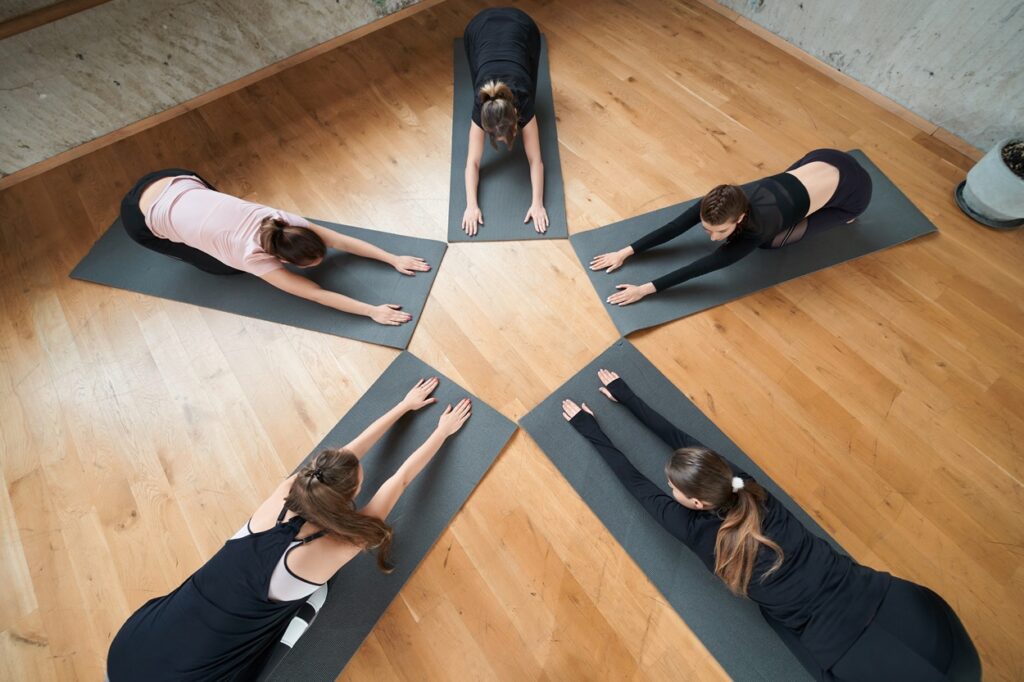Restorative Yoga For Beginners at Home:
In the fast-paced rhythm of modern life, finding time to relax and rejuvenate is crucial. Restorative yoga, known for its gentle, healing, and nurturing qualities, offers a perfect antidote to stress and fatigue. This yoga style uses props to support the body in positions of comfort and ease, facilitating deeper relaxation and rejuvenation. In this blog post, we’ll delve into the restorative yoga practices that can help you revitalize and refresh your body and mind.

Related Article: A Simple Guide to Yoga Bolsters: Don’t Shy Away!
Understanding Restorative Yoga
Restorative yoga is characterized by its focus on relaxation, mindfulness, and the release of tension through gentle stretching and breathing exercises. Unlike more active yoga styles, restorative yoga emphasizes stillness and the holding of poses for extended periods.
Key Poses in Restorative Yoga
- Supported Child’s Pose (Balasana): This pose calms the mind and gently stretches the back. Using a bolster or pillows under your torso can add extra comfort and support.
- Legs-Up-The-Wall Pose (Viparita Karani): This inversion is excellent for relieving tired legs and feet and can help improve circulation.
- Supported Bridge Pose (Setu Bandhasana): With a block or bolster under the sacrum, this pose gently stretches the spine and relieves tension in the lower back.
- Reclining Bound Angle Pose (Supta Baddha Konasana): This pose opens the hips and chest, encouraging deep relaxation. Props can be used to support the knees.
The Role of Breathwork in Restorative Yoga
Breathwork, known as pranayama in the context of yoga, plays a crucial role in enhancing the effectiveness of a restorative yoga practice. Integrating specific breathing techniques into restorative yoga sessions can significantly amplify the benefits, particularly in terms of relaxation and stress reduction.
Key Breathwork Techniques in Restorative Yoga
- Deep Abdominal Breathing:
- Technique: Involves slow, deep inhalations and exhalations, focusing on expanding and contracting the abdomen.
- Benefits: This form of breathing promotes relaxation by activating the parasympathetic nervous system, often referred to as the ‘rest and digest’ system. It helps in reducing heart rate and promoting a sense of calm.
- Alternate Nostril Breathing (Nadi Shodhana):
- Technique: This involves alternately inhaling through one nostril and exhaling through the other by gently closing each nostril in turn with the fingers.
- Benefits: Nadi Shodhana is known for its ability to balance the left and right hemispheres of the brain, leading to mental clarity and reduced anxiety. It is particularly beneficial in calming the mind and preparing it for meditation or deeper relaxation.
Integrating Breathwork into Restorative Poses
- During Poses: Incorporating these breathing techniques while holding restorative poses can deepen the relaxation experience. For instance, while in a gentle spinal twist or a supported forward bend, focusing on deep, rhythmic breathing can enhance the stretch and the calming effect.
- Transitions Between Poses: Utilizing breathwork during transitions between different restorative poses can help maintain a state of relaxation and mindfulness throughout the practice.
- Beginning and End of Practice: Starting and concluding a restorative yoga session with a few minutes of focused breathwork can set the tone for the practice and help in consolidating its relaxing effects.
Integrating breathwork into restorative yoga not only augments the physical benefits of the poses but also significantly enhances mental relaxation and stress relief. This symbiotic relationship between breath and posture is a cornerstone of restorative yoga, making it an exceptionally holistic approach to well-being.
Exploring the Advantages of Restorative Yoga
Restorative yoga is a practice rich in benefits, offering a multitude of positive impacts on both physical and mental health. Its gentle nature makes it accessible to a wide range of individuals, including those recovering from illness or injury, as well as anyone seeking a peaceful and rejuvenating yoga experience.
Key Benefits of Restorative Yoga
- Stress and Anxiety Reduction:
- One of the most notable benefits is the significant decrease in stress and anxiety levels. The calming nature of restorative yoga helps in soothing the nervous system, leading to reduced cortisol levels and a relaxed state of mind.
- Improved Sleep Quality:
- Regular practice of restorative yoga can contribute to better sleep patterns. The relaxation techniques used in this form of yoga prepare the body and mind for a deeper, more restful sleep.
- Enhanced Flexibility:
- Although the movements are slow and gentle, restorative yoga effectively increases flexibility. Holding poses for extended periods allows the muscles to relax and stretch without strain.
- Balance and Inner Peace:
- This yoga style promotes a sense of balance and inner peace, helping practitioners to cultivate a deeper connection with their inner selves. The focus on mindfulness and breathwork in restorative yoga nurtures a state of mental equilibrium.
- Recovery Support:
- For individuals recovering from illness or injury, restorative yoga can be an invaluable tool. The gentle poses and focus on relaxation aid in the body’s healing process and can be adapted to accommodate physical limitations.
- Disconnect and Rejuvenation:
- In today’s fast-paced world, restorative yoga offers an opportunity to disconnect from daily stressors and rejuvenate both body and mind. It’s an effective way to take a break and focus on self-care.
Related Article: The Role of Yoga For Injury Rehabilitation and Recovery!
Creating a Restorative Yoga Routine
To get the most out of restorative yoga, create a comfortable space where you won’t be disturbed. Use props like yoga blocks, bolsters, blankets, and eye pillows to support your body in the poses. Allow enough time in each pose to let go fully, usually 5-10 minutes.
Enhancing Restorative Yoga with Mindfulness and Meditation
Incorporating elements of mindfulness and meditation into a restorative yoga routine can significantly amplify its healing and restorative properties. These practices help in fostering a deeper connection between the mind and body, leading to a more profound state of relaxation and rejuvenation.
Integrating Mindfulness in Restorative Yoga
- Breath Awareness:
- Focusing on your breath is a fundamental aspect of mindfulness in yoga. Paying attention to the rhythm and depth of your breath during restorative poses helps in anchoring the mind in the present moment, enhancing relaxation.
- Body Scan Meditation:
- Practicing a body scan meditation involves slowly moving your attention through different parts of the body. This practice can be particularly effective during longer holds in restorative poses, as it encourages a deep awareness of bodily sensations and helps release tension.
Benefits of Mindfulness and Meditation in Yoga
- Deepened Mind-Body Connection: Mindfulness practices like breath awareness and body scan meditation deepen the connection between the mind and body, leading to a more integrated and holistic yoga experience.
- Enhanced Relaxation: The meditative aspect of restorative yoga, combined with mindfulness techniques, facilitates a deeper level of relaxation, both physically and mentally.
- Stress and Anxiety Relief: These practices are particularly effective in alleviating stress and anxiety, as they encourage a state of calm and present-moment awareness.
- Cultivating Inner Peace: Regular incorporation of mindfulness and meditation in restorative yoga can cultivate a lasting sense of peace and tranquility, extending beyond the yoga mat into daily life.
Adapting Restorative Yoga for Home Practice
Practicing restorative yoga at home can be a deeply personal and rewarding experience. You can tailor your practice to fit your specific needs and schedule. Start with simple poses and gradually incorporate more as you become comfortable. Using household items like pillows, blankets, and books as props can make this practice accessible and enjoyable.
Integrating Restorative Yoga into Everyday Life
Adding restorative yoga to your daily routine can be both simple and highly beneficial, without demanding a significant amount of time. Short sessions, ranging from 15 to 20 minutes, can yield substantial positive effects on your overall well-being.
Convenient Practice Times
- Evening Sessions for Relaxation:
- Practicing restorative yoga in the evening is an excellent way to unwind and relax before bedtime. It can help ease the transition into a restful night’s sleep, reducing stress and calming the mind.
- Morning Practice for a Serene Start:
- Incorporating restorative yoga into your morning routine can set a peaceful tone for the day ahead. It allows you to begin your day with a sense of calmness and centeredness, positively impacting your mood and mindset.
Adaptable and Flexible
- Customizable Duration: The flexibility of restorative yoga means that even if you have just a few minutes to spare, you can engage in a practice that fits your schedule.
- Suitable for Any Setting: Whether you have a dedicated yoga space or a small area in your living room, restorative yoga can be adapted to fit your environment.
Benefits of Daily Practice
- Consistent Relaxation: Regular practice helps in maintaining a consistent state of relaxation and stress relief.
- Improved Mental Clarity: Daily engagement in restorative yoga can enhance mental clarity, making it easier to focus and stay productive.
- Physical Health Improvements: Over time, consistent practice can lead to improvements in flexibility, posture, and overall physical health.
Incorporating restorative yoga into your daily routine offers a practical and effective way to manage stress, improve mental clarity, and enhance physical well-being, all within a manageable time frame.
Restorative Yoga and Emotional Well-Being
Restorative yoga is not only beneficial for physical relaxation but also for emotional well-being. The practice encourages mindfulness and presence, which can help in managing emotions and reducing feelings of stress and anxiety. The nurturing and calming nature of restorative poses can offer a safe space for emotional release and comfort.
Combining Restorative Yoga with Other Wellness Practices
For a holistic approach to wellness, consider combining restorative yoga with other practices like aromatherapy, gentle music, or journaling. This combination can enhance the relaxation experience, leading to a deeper sense of peace and rejuvenation.
Restorative Yoga Poses and Their Benefits
| Pose | Benefits | Tips |
|---|---|---|
| Supported Child’s Pose | Calms the mind, stretches the back | Use a bolster or pillows for added comfort |
| Legs-Up-The-Wall Pose | Relieves tired legs, improves circulation | Support the lower back with a small cushion |
| Supported Bridge Pose | Stretches the spine, relieves back tension | Place a block or bolster under the sacrum |
| Reclining Bound Angle Pose | Opens hips and chest, encourages relaxation | Use props to support the knees |
Related Article: Restorative Yoga For Beginners: Simple. Popular. Effective!
Final Thoughts
Restorative yoga is an invaluable practice for beginners and experienced yogis alike, especially when looking for ways to relax and rejuvenate in the comfort and privacy of home. Its gentle nature makes it accessible to people of all ages and fitness levels.
The key to a successful restorative yoga practice at home is to create a supportive environment, use props effectively, and allow yourself the grace to relax deeply into each pose. Remember, the goal is not to stretch or strengthen but to release and let go. This practice serves as a reminder of the importance of slowing down and listening to your body.
As you continue your journey with restorative yoga, you may find not just physical relaxation but also a deeper sense of emotional balance and inner peace. Embrace this practice as a gift to yourself, a time to nurture your body and mind in a world that often demands constant activity and productivity.
References:
https://www.med.unc.edu/phyrehab/wp-content/uploads/sites/549/2019/09/9.13.2019-Wellness.pdf




